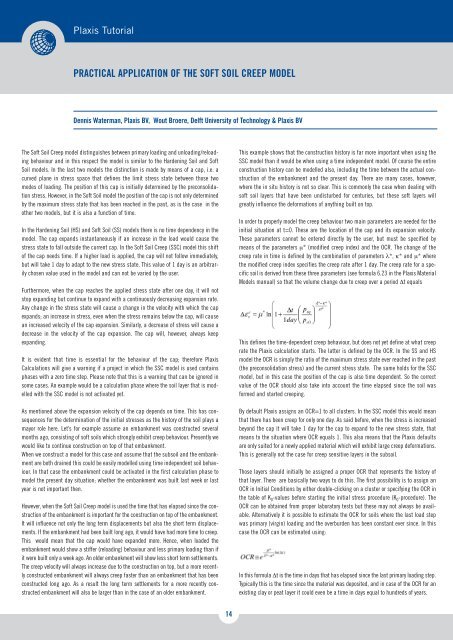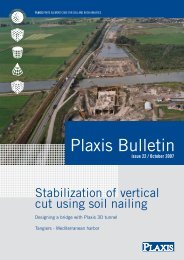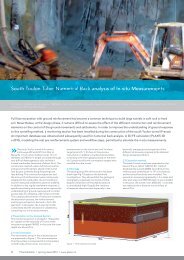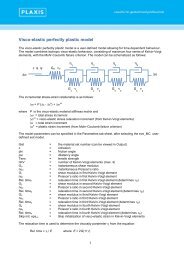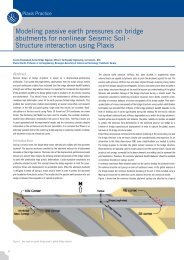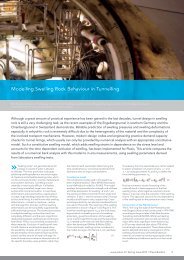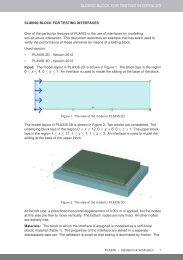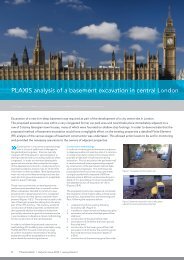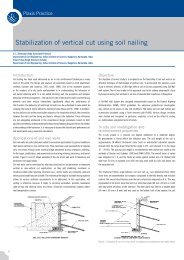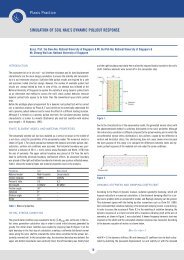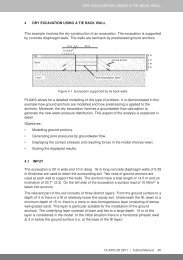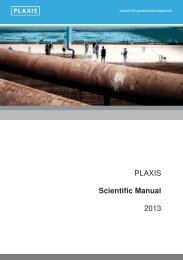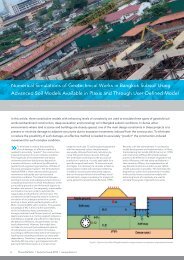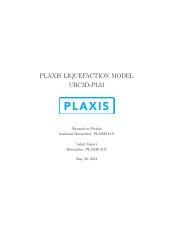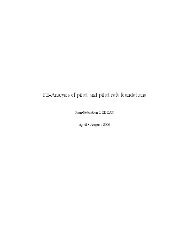Waterman, D., Broere, W., 2004, Application of the SSC model - Plaxis
Waterman, D., Broere, W., 2004, Application of the SSC model - Plaxis
Waterman, D., Broere, W., 2004, Application of the SSC model - Plaxis
Create successful ePaper yourself
Turn your PDF publications into a flip-book with our unique Google optimized e-Paper software.
<strong>Plaxis</strong> Tutorial<br />
PRACTICAL APPLICATION OF THE SOFT SOIL CREEP MODEL<br />
Dennis <strong>Waterman</strong>, <strong>Plaxis</strong> BV, Wout <strong>Broere</strong>, Delft University <strong>of</strong> Technology & <strong>Plaxis</strong> BV<br />
The S<strong>of</strong>t Soil Creep <strong>model</strong> distinguishes between primary loading and unloading/reloading<br />
behaviour and in this respect <strong>the</strong> <strong>model</strong> is similar to <strong>the</strong> Hardening Soil and S<strong>of</strong>t<br />
Soil <strong>model</strong>s. In <strong>the</strong> last two <strong>model</strong>s <strong>the</strong> distinction is made by means <strong>of</strong> a cap, i.e. a<br />
curved plane in stress space that defines <strong>the</strong> limit stress state between those two<br />
modes <strong>of</strong> loading. The position <strong>of</strong> this cap is initially determined by <strong>the</strong> preconsolidation<br />
stress. However, in <strong>the</strong> S<strong>of</strong>t Soil <strong>model</strong> <strong>the</strong> position <strong>of</strong> <strong>the</strong> cap is not only determined<br />
by <strong>the</strong> maximum stress state that has been reached in <strong>the</strong> past, as is <strong>the</strong> case in <strong>the</strong><br />
o<strong>the</strong>r two <strong>model</strong>s, but it is also a function <strong>of</strong> time.<br />
In <strong>the</strong> Hardening Soil (HS) and S<strong>of</strong>t Soil (SS) <strong>model</strong>s <strong>the</strong>re is no time dependency in <strong>the</strong><br />
<strong>model</strong>. The cap expands instantaneously if an increase in <strong>the</strong> load would cause <strong>the</strong><br />
stress state to fall outside <strong>the</strong> current cap. In <strong>the</strong> S<strong>of</strong>t Soil Creep (<strong>SSC</strong>) <strong>model</strong> this shift<br />
<strong>of</strong> <strong>the</strong> cap needs time. If a higher load is applied, <strong>the</strong> cap will not follow immediately,<br />
but will take 1 day to adapt to <strong>the</strong> new stress state. This value <strong>of</strong> 1 day is an arbitrarily<br />
chosen value used in <strong>the</strong> <strong>model</strong> and can not be varied by <strong>the</strong> user.<br />
Fur<strong>the</strong>rmore, when <strong>the</strong> cap reaches <strong>the</strong> applied stress state after one day, it will not<br />
stop expanding but continue to expand with a continuously decreasing expansion rate.<br />
Any change in <strong>the</strong> stress state will cause a change in <strong>the</strong> velocity with which <strong>the</strong> cap<br />
expands; an increase in stress, even when <strong>the</strong> stress remains below <strong>the</strong> cap, will cause<br />
an increased velocity <strong>of</strong> <strong>the</strong> cap expansion. Similarly, a decrease <strong>of</strong> stress will cause a<br />
decrease in <strong>the</strong> velocity <strong>of</strong> <strong>the</strong> cap expansion. The cap will, however, always keep<br />
expanding.<br />
It is evident that time is essential for <strong>the</strong> behaviour <strong>of</strong> <strong>the</strong> cap; <strong>the</strong>refore <strong>Plaxis</strong><br />
Calculations will give a warning if a project in which <strong>the</strong> <strong>SSC</strong> <strong>model</strong> is used contains<br />
phases with a zero time step. Please note that this is a warning that can be ignored in<br />
some cases. An example would be a calculation phase where <strong>the</strong> soil layer that is <strong>model</strong>led<br />
with <strong>the</strong> <strong>SSC</strong> <strong>model</strong> is not activated yet.<br />
As mentioned above <strong>the</strong> expansion velocity <strong>of</strong> <strong>the</strong> cap depends on time. This has consequences<br />
for <strong>the</strong> determination <strong>of</strong> <strong>the</strong> initial stresses as <strong>the</strong> history <strong>of</strong> <strong>the</strong> soil plays a<br />
mayor role here. Let’s for example assume an embankment was constructed several<br />
months ago, consisting <strong>of</strong> s<strong>of</strong>t soils which strongly exhibit creep behaviour. Presently we<br />
would like to continue construction on top <strong>of</strong> that embankment.<br />
When we construct a <strong>model</strong> for this case and assume that <strong>the</strong> subsoil and <strong>the</strong> embankment<br />
are both drained this could be easily <strong>model</strong>led using time independent soil behaviour.<br />
In that case <strong>the</strong> embankment could be activated in <strong>the</strong> first calculation phase to<br />
<strong>model</strong> <strong>the</strong> present day situation; whe<strong>the</strong>r <strong>the</strong> embankment was built last week or last<br />
year is not important <strong>the</strong>n.<br />
However, when <strong>the</strong> S<strong>of</strong>t Soil Creep <strong>model</strong> is used <strong>the</strong> time that has elapsed since <strong>the</strong> construction<br />
<strong>of</strong> <strong>the</strong> embankment is important for <strong>the</strong> construction on top <strong>of</strong> <strong>the</strong> embankment.<br />
It will influence not only <strong>the</strong> long term displacements but also <strong>the</strong> short term displacements.<br />
If <strong>the</strong> embankment had been built long ago, it would have had more time to creep.<br />
This would mean that <strong>the</strong> cap would have expanded more. Hence, when loaded <strong>the</strong><br />
embankment would show a stiffer (reloading) behaviour and less primary loading than if<br />
it were built only a week ago. An older embankment will show less short term settlements.<br />
The creep velocity will always increase due to <strong>the</strong> construction on top, but a more recently<br />
constructed embankment will always creep faster than an embankment that has been<br />
constructed long ago. As a result <strong>the</strong> long term settlements for a more recently constructed<br />
embankment will also be larger than in <strong>the</strong> case <strong>of</strong> an older embankment.<br />
This example shows that <strong>the</strong> construction history is far more important when using <strong>the</strong><br />
<strong>SSC</strong> <strong>model</strong> than it would be when using a time independent <strong>model</strong>. Of course <strong>the</strong> entire<br />
construction history can be <strong>model</strong>led also, including <strong>the</strong> time between <strong>the</strong> actual construction<br />
<strong>of</strong> <strong>the</strong> embankment and <strong>the</strong> present day. There are many cases, however,<br />
where <strong>the</strong> in situ history is not so clear. This is commonly <strong>the</strong> case when dealing with<br />
s<strong>of</strong>t soil layers that have been undisturbed for centuries, but <strong>the</strong>se s<strong>of</strong>t layers will<br />
greatly influence <strong>the</strong> deformations <strong>of</strong> anything built on top.<br />
In order to properly <strong>model</strong> <strong>the</strong> creep behaviour two main parameters are needed for <strong>the</strong><br />
initial situation at t=0. These are <strong>the</strong> location <strong>of</strong> <strong>the</strong> cap and its expansion velocity.<br />
These parameters cannot be entered directly by <strong>the</strong> user, but must be specified by<br />
means <strong>of</strong> <strong>the</strong> parameters µ* (modified creep index) and <strong>the</strong> OCR. The change <strong>of</strong> <strong>the</strong><br />
creep rate in time is defined by <strong>the</strong> combination <strong>of</strong> parameters λ*, κ* and µ* where<br />
<strong>the</strong> modified creep index specifies <strong>the</strong> creep rate after 1 day. The creep rate for a specific<br />
soil is derived from <strong>the</strong>se three parameters (see formula 6.23 in <strong>the</strong> <strong>Plaxis</strong> Material<br />
Models manual) so that <strong>the</strong> volume change due to creep over a period ∆t equals<br />
This defines <strong>the</strong> time-dependent creep behaviour, but does not yet define at what creep<br />
rate <strong>the</strong> <strong>Plaxis</strong> calculation starts. The latter is defined by <strong>the</strong> OCR. In <strong>the</strong> SS and HS<br />
<strong>model</strong> <strong>the</strong> OCR is simply <strong>the</strong> ratio <strong>of</strong> <strong>the</strong> maximum stress state ever reached in <strong>the</strong> past<br />
(<strong>the</strong> preconsolidation stress) and <strong>the</strong> current stress state. The same holds for <strong>the</strong> <strong>SSC</strong><br />
<strong>model</strong>, but in this case <strong>the</strong> position <strong>of</strong> <strong>the</strong> cap is also time dependent. So <strong>the</strong> correct<br />
value <strong>of</strong> <strong>the</strong> OCR should also take into account <strong>the</strong> time elapsed since <strong>the</strong> soil was<br />
formed and started creeping.<br />
By default <strong>Plaxis</strong> assigns an OCR=1 to all clusters. In <strong>the</strong> <strong>SSC</strong> <strong>model</strong> this would mean<br />
that <strong>the</strong>re has been creep for only one day. As said before, when <strong>the</strong> stress is increased<br />
beyond <strong>the</strong> cap it will take 1 day for <strong>the</strong> cap to expand to <strong>the</strong> new stress state, that<br />
means to <strong>the</strong> situation where OCR equals 1. This also means that <strong>the</strong> <strong>Plaxis</strong> defaults<br />
are only suited for a newly applied material which will exhibit large creep deformations.<br />
This is generally not <strong>the</strong> case for creep sensitive layers in <strong>the</strong> subsoil.<br />
Those layers should initially be assigned a proper OCR that represents <strong>the</strong> history <strong>of</strong><br />
that layer. There are basically two ways to do this. The first possibility is to assign an<br />
OCR in Initial Conditions by ei<strong>the</strong>r double-clicking on a cluster or specifying <strong>the</strong> OCR in<br />
<strong>the</strong> table <strong>of</strong> K 0 -values before starting <strong>the</strong> initial stress procedure (K 0 -procedure). The<br />
OCR can be obtained from proper laboratory tests but <strong>the</strong>se may not always be available.<br />
Alternatively it is possible to estimate <strong>the</strong> OCR for soils where <strong>the</strong> last load step<br />
was primary (virgin) loading and <strong>the</strong> overburden has been constant ever since. In this<br />
case <strong>the</strong> OCR can be estimated using:<br />
In this formula ∆t is <strong>the</strong> time in days that has elapsed since <strong>the</strong> last primary loading step.<br />
Typically this is <strong>the</strong> time since <strong>the</strong> material was deposited, and in case <strong>of</strong> <strong>the</strong> OCR for an<br />
existing clay or peat layer it could even be a time in days equal to hundreds <strong>of</strong> years.<br />
14
The second possibility to assign a correct OCR value in <strong>Plaxis</strong> is to leave <strong>the</strong> OCR equal<br />
to 1 in <strong>the</strong> initial conditions and start <strong>the</strong> calculation with a plastic nil step. For this<br />
phase set <strong>the</strong> time interval equal to ∆t. <strong>Plaxis</strong> will now calculate <strong>the</strong> stress state due<br />
<strong>the</strong> creep over that period, which results in a certain OCR. In <strong>the</strong> second phase <strong>of</strong> <strong>the</strong><br />
calculation <strong>the</strong> settlements due to <strong>the</strong> simulation <strong>of</strong> <strong>the</strong> creep history must be discarded<br />
using <strong>the</strong> “reset displacements to zero” option in <strong>Plaxis</strong> Calculations.<br />
Generally, if ∆t is large <strong>the</strong> exact value becomes less important, as <strong>the</strong> OCR depends<br />
on natural logarithm <strong>of</strong> time. It makes a large difference whe<strong>the</strong>r soil has been in place<br />
for 10 days or 1 year, but <strong>the</strong>re will be relatively little additional creep between 100<br />
years or 200 years.<br />
When generating <strong>the</strong> initial stresses using <strong>the</strong> K 0 -procedure, <strong>the</strong> influence <strong>of</strong> <strong>the</strong> OCR<br />
warrants some extra attention. The initial vertical preconsolidation stress at a certain<br />
depth is calculated, as might be expected, from <strong>the</strong> effective weight <strong>of</strong> <strong>the</strong> soil on top<br />
multiplied by <strong>the</strong> OCR value that has been entered (σ c = OCR . σ' y ). When a plot <strong>of</strong> <strong>the</strong><br />
OCR values obtained in this way is inspected, it can be noticed that <strong>the</strong> reported OCR<br />
values differ slightly from <strong>the</strong> enter value. The reason for this is that <strong>the</strong> OCR value<br />
<strong>Plaxis</strong> Output reports is calculated using <strong>the</strong> stress measure p eq , defined as<br />
This stress measure is used internally by <strong>Plaxis</strong> to define OCR from p p = OCR . p eq . The<br />
reason for this is that <strong>the</strong> regular definition <strong>of</strong> OCR (σ c = OCR . σ' y ) is not always<br />
meaningful in complex 3D loading situations. And although it would be preferable to<br />
report OCRs using <strong>the</strong> same definition as used in <strong>the</strong> initial conditions, unfortunately it<br />
is not possible to derive Cartesian stresses from p eq in case <strong>the</strong> cohesion is nonzero.<br />
In order to illustrate this a simple example is given. Define in <strong>Plaxis</strong> V8 a square <strong>of</strong> 1x1m<br />
with standard boundary conditions and a distributed load on top.<br />
Define a material data set using <strong>the</strong> S<strong>of</strong>t Soil Creep <strong>model</strong> and <strong>the</strong> material type set to<br />
drained. O<strong>the</strong>r material parameters are given in table 1. Normally one would use<br />
undrained material behaviour but to more clearly illustrate creep only drained behaviour<br />
is selected here.<br />
Parameter Name Value Unit<br />
Material <strong>model</strong> Model S<strong>of</strong>t Soil Creep -<br />
Type <strong>of</strong> material behaviour Type Drained -<br />
Unit weight <strong>of</strong> soil above phreatic level γ unsat 17.0 kN/m 3<br />
Unit weight <strong>of</strong> soil below phreatic level γ sat 17.0 kN/m 3<br />
Modified compression modulus λ* 0.025 -<br />
Modified swelling modulus κ* 0.010 -<br />
Modified creep modulus µ* 0.001 -<br />
Cohesion (constant) c ref 1.0 kN/m 2<br />
Friction angle φ 28.0 º<br />
Dilatancy angle ψ 0.0 º<br />
Table 1: Material parameters<br />
For this case <strong>the</strong> sample is assumed dry and for initial stresses generation <strong>the</strong> default<br />
values for K 0 and OCR are used. The calculation consists <strong>of</strong> 5 phases:<br />
1. A load <strong>of</strong> -100 kPa is applied at <strong>the</strong> top with time interval zero.<br />
2. A staged construction phase with a time interval <strong>of</strong> 100 days. Use <strong>the</strong> “reset displacements<br />
to zero” option.<br />
3. Starting from <strong>the</strong> initial phase once more add a staged construction phase with a<br />
time interval <strong>of</strong> 36500 days (100 years).<br />
4. A load <strong>of</strong> -100 kPa is applied at <strong>the</strong> top with time interval zero.<br />
5. A staged construction phase with a time interval <strong>of</strong> 100 days. Use <strong>the</strong> “reset displacements<br />
to zero” option.<br />
Start <strong>the</strong> calculation and ignore <strong>the</strong> warning about calculation phases with zero time<br />
interval.<br />
Figure 2 shows a graph <strong>of</strong> <strong>the</strong> displacements vs. time for a node in <strong>the</strong> sample. The<br />
additional resting time <strong>of</strong> phase 3 increased <strong>the</strong> OCR from 1 to approximately 2.4<br />
resulting in a stiffer behaviour <strong>of</strong> <strong>the</strong> sample as can be seen from <strong>the</strong> figure.<br />
0,000<br />
-0,005<br />
Uy (m)<br />
-0,010<br />
-0,015<br />
-0,020<br />
-0,025<br />
-0,030<br />
-0,035<br />
loading after 100 years<br />
-0,040<br />
-0,045<br />
immediate loading<br />
-0,050<br />
0 20 40 60 80 100 120<br />
Time (days)<br />
Figure 1: Geometry used in this example.<br />
Figure 2: Time - settlement curve.<br />
15


